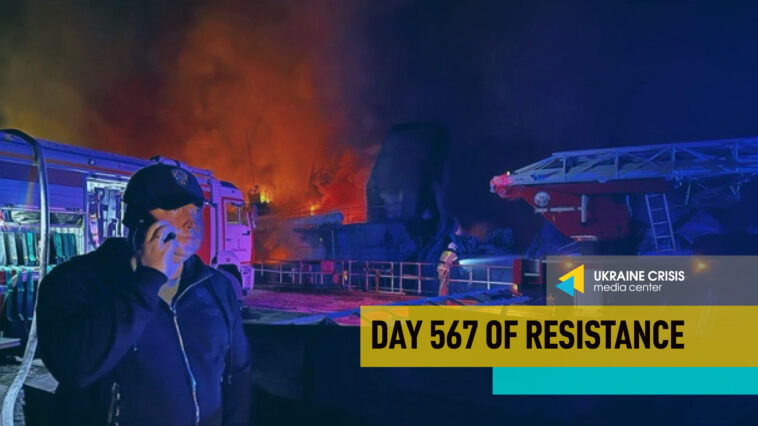Ukrainian missiles and unmanned boats strike a shipyard in Sevastopol. Russia’s overnight drone strike on ports in Odesa region damages grain warehouses, injures seven. Russia overcomes sanctions to expand missile production, officials quoted by The New York Times say.
Operation that will make history: Ukraine strikes shipyard in Sevastopol
Overnight on Wednesday, September 13, several powerful explosions were reported in Sevastopol, in occupied Crimea.
Russia-installed governor of Sevastopol Mikhail Razvozayev said a missile strike sparked “a fire at a non-civilian facility” in the Kilen-Balka area in the Nakhimovskiy district. The fire has been assigned class four of the six possible.
Russia’s Defense Ministry said Ukraine launched an attack with missiles and unmanned boats. It struck a shipyard in Sevastopol, damaging two ships “undergoing repairs”, and attacked “a group of Black Sea Fleet ships crossing the sea”.
The Main Intelligence Directorate of Ukraine’s Defense Ministry confirmed that two vessels had been struck: a large landing ship and a submarine. Russian and European sources said a submarine, called the Rostov-on-Don, and a large landing ship, named the Minsk, had been damaged.
Some OSINT analysts said that low-resolution satellite imagery seemed to confirm reports that two Russian warships in a dry dock, likely a Kilo-class sub and a Ropucha-class landing ship, had been destroyed or heavily damaged.
A fire that erupted at the shipyard in Sevastopol after a missile strike forces a shift in Russian logistics planning, Maksym Palamarchuk, expert at the National Institute for Strategic Studies told Radio NV.
“Damage to the shipyard will decrease the enemy’s capacity to repair vessels. A ship damaged by a naval drone would be normally taken out of service for half of a year. It could now remain out of service until the end of the war,” he said.
Russia could only send its ships to repair elsewhere using internal waters, as Turkey has closed the Black Sea straits to warships. Moving the shipyard elsewhere is not feasible, Palamarchuk said.
Later on Wednesday, Ukraine’s Navy said the southern group of the defense forces had destroyed a Russian KS-701 Tunets patrol boat in the north-western part of the Black Sea.
Russia’s overnight drone strike on ports in Odesa region damages grain warehouses, injures seven
Overnight on September 13, Russia launched a drone strike on the Danube ports of Reni and Izmail in Odesa region, damaging grain warehouses, sunflower oil tanks, vehicles, and injuring seven drivers. They are in hospital in serious condition, Oleksandr Kubrakov, Deputy Prime Minister for Restoration of Ukraine – Minister for Communities, Territories, and Infrastructure Development said in a statement in English posted to Facebook.
“Despite the aggressor’s attempts to reduce its export potential, the ports continue to operate. At the same time, every attack on the port infrastructure of Ukraine is an attack on the food security of the whole world,” Kubrakov said.
“Since July 18, due to Russian attacks on Ukrainian ports, 105 port infrastructure facilities have been damaged and partially destroyed. As a result of strikes on the ports of the Danube cluster and the blocking of seaports, grain exports to Asia, Africa and Europe were reduced by almost 3 million tons per month,” the message reads.
“The ports of the Danube cluster are currently the only waterway for Ukrainian agricultural exports. If you do not protect it with powerful air defense systems, the consequences will be much worse. First of all, for those countries that depend on Ukrainian agricultural products,” Kubrakov added.
In its statement, the UK’s Foreign Office said Russia’s bombardment of Ukrainian ports and grain infrastructure has destroyed 280,000 tons of grain since Russia pulled out of the grain deal in July 2023.
Russia overcomes sanctions to expand missile production, officials quoted by NYT say
Russia has managed to overcome sanctions and export controls imposed by the West to expand its missile production beyond prewar levels, according to U.S., European and Ukrainian officials, leaving Ukraine especially vulnerable to intensified attacks in the coming months, an article by The New York Times sais.
As a result of the sanctions, American officials estimate that Russia was forced to dramatically slow its production of missiles and other weaponry at the start of the war in February 2022 for at least six months. But by the end of 2022, Moscow’s military industrial manufacturing began to pick up speed again, American officials who spoke on condition of anonymity to disclose the sensitive assessment now concede.
In the meantime, the Pentagon is working to find ways to help Ukrainians better take down the missiles and drones fired by Russia at civilian targets in Kyiv and military targets around the country.
Russia subverted American export controls using its intelligence services and ministry of defense to run illicit networks of people who smuggle key components by exporting them to other countries from which they can be shipped to Russia more easily. In less than a year since the war began, Russia rebuilt trade in critical components by routing them through countries like Armenia and Turkey.
Russia has used its missiles to attack Ukraine’s electric grid. Officials fear that increased missile stocks could mean an especially dark and cold winter for Ukrainian citizens.
One of the challenges for the U.S. government is that Russia does not need higher-end chips that are easier to track, but commoditized chips that can be used in a wide range of things, not just guided missiles.
Western officials also believe Russia is on track to manufacture two million artillery shells a year. As a result of the push, Russia is now producing more ammunition than the United States and Europe. Russian production is still not keeping pace with how fast the military is burning through ammunition and wearing out equipment. For example, even though Russia is on pace to produce two million rounds of ammunition a year, it fired about 10 million rounds of artillery last year. Russia’s increased military production has also come at a great cost to the Russian economy, particularly as interest rates spike in the country.




